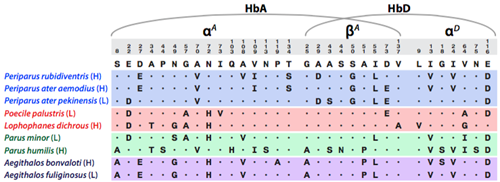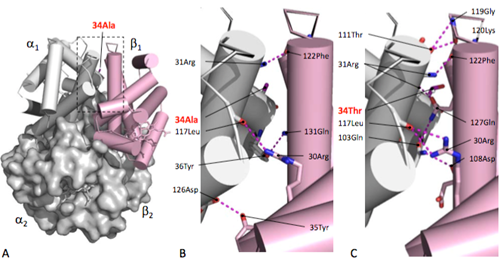Adaptive evolution in high-altitude vertebrates has been focused by scientists from medicine to evolutionary biologists for a century. Because of a different cardiorespiratory system and physiological regulation, the molecular mechanisms under adaptation in high-altitude environment evolved distinctively in birds from that in mammals.
Previous studies on Andean birds revealed that a convergent increase of hemoglobin-O2 affinity might be caused by multiple various combinations of amino acid substitutions and their effective mechanisms. To test whether a general underlying mechanism exists in birds, more investigations of birds distributed worldwide in the high altitudes are necessarily required.
To figure out the common divergent molecular mechanisms under adaptive convergence in birds, the international joint team lead by Prof. LEI Fumin from Institute of Zoology, Chinese Academy of Sciences and Prof. Jay Storz from School of Biological Sciences, University of Nebraska investigated the high-altitude adaptation of passerine birds, Paridae and Aegithalidae on the Qinghai-Tibet Plateau (QTP).
They found the derived increases in Hb-O2 affinity in high-altitude Parids and Aegithalids from the high altitude evolved in contrast to their closest lowland relatives in East Asia.
They further compared high-altitude passerines in the Sino-Himalayan region with a phylogenetically distinct set of high-altitude Andean birds.
To their expectation, convergence in Hb-O2 affinity and underlying molecular mechanisms were proved to be seldom attributable to the same amino acid substitutions in birds from the Andean alpines and the QTP.
In two experimentally confirmed cases of the latter, convergent increases in Hb-O2 affinity in co-distributed high-altitude species were contributable to parallel substitutions at the same site.
One is in sympatric but distantly related species, Black-browed bushtit (Aegithalos bonvaloti) and Bar-headed goose (Anser indicus), a unique substitution αAP119A in each family caused the convergent increasing of HbA-O2 affinity in the two distantly related species. The Bar-headed goose is renowned for a high-altitude species and a long-distance trans-Himalayan migrant.
The other parallel αAA34T substitutions in Grey-crested tit Lophophanes dichrous and Ground tit Parus humilis were confirmed in convergent increase Hb-O2 affinity.
However, the structural modeling results were predicted in different, which is in shifting the allosteric equilibrium for the former but in destabilization of the T-state and stabilization of the R-state for the latter.
Furthermore, the αAA34T substitution was caused by a mutation bias occurred in CpG dinucleotide, which was also found in convergent increase of Hb-O2 affinity in Andean house wrens.
This work finally confirmed that the altitude-related changes in Hb function in birds were generally caused by divergent amino acid substitutions, whereas rare cases were contributable to parallel substitutions that result in similar phenotypic effects on the divergent genetic backgrounds of different species.
The research paper entitled "Divergent and parallel routes of biochemical adaptation in high-altitude passerine birds from the Qinghai-Tibet Plateau" was published online in PNAS.

A multiple alignment of αA-, αD-, and βA-globin residual variants in the genotyping of Hb phenotypes.

Homology structure model for the mechanism of parallel αAAla34Thr substitution under a convergent increase in high-altitude Ground tit (Parus humilis) and Grey-crested tit (Lophophanes dichrous).(Image by IOZ)

